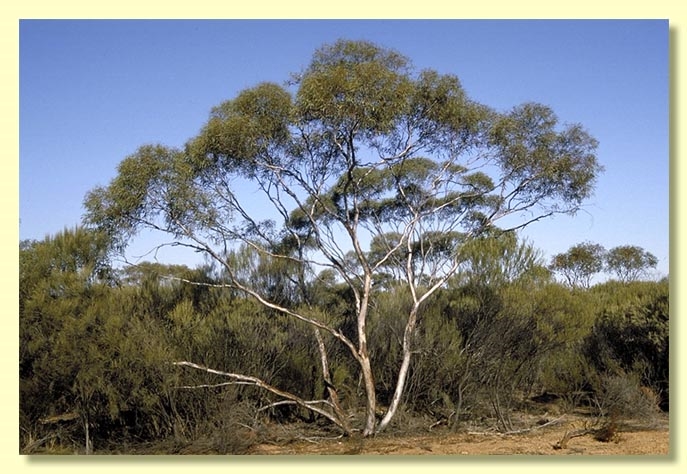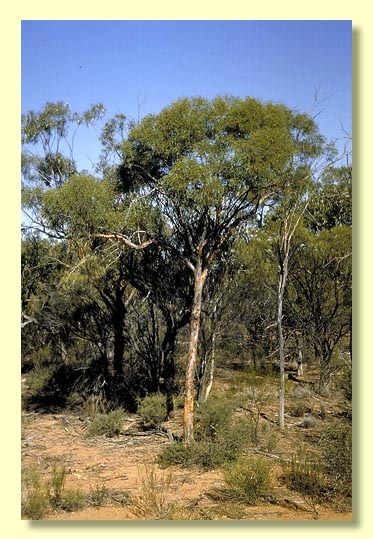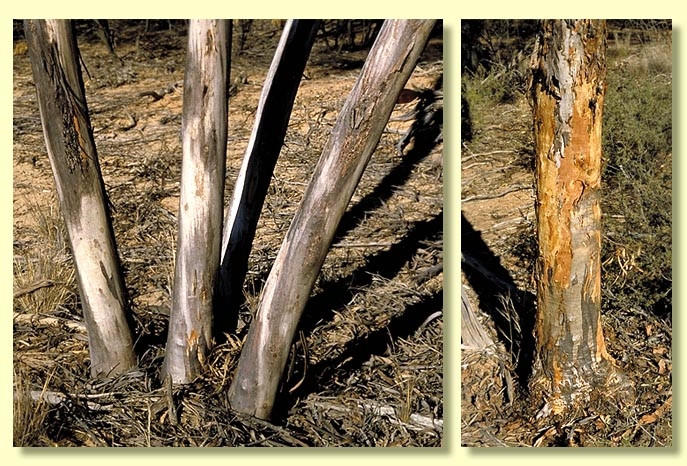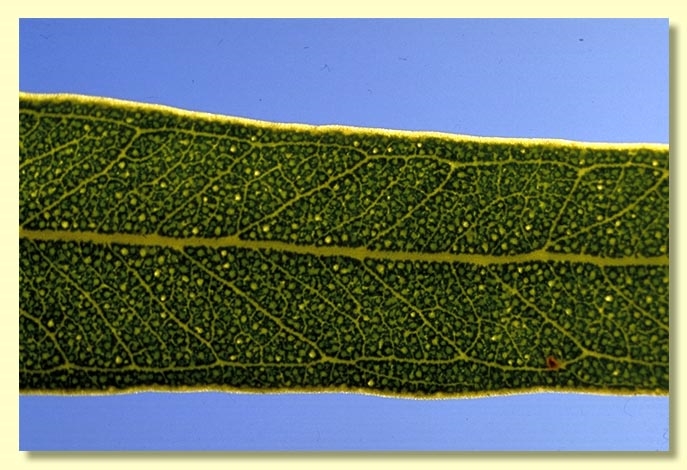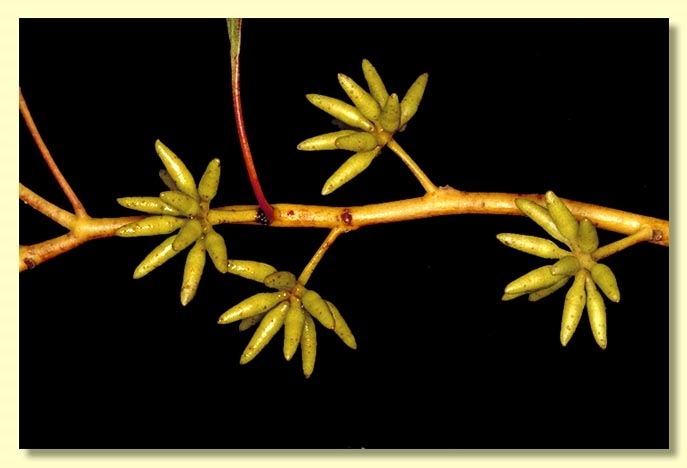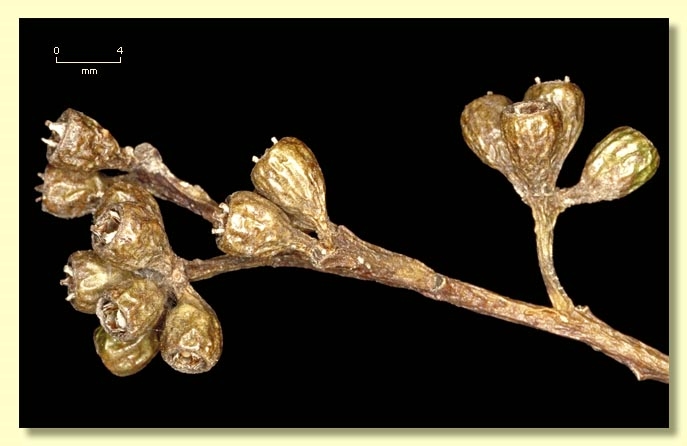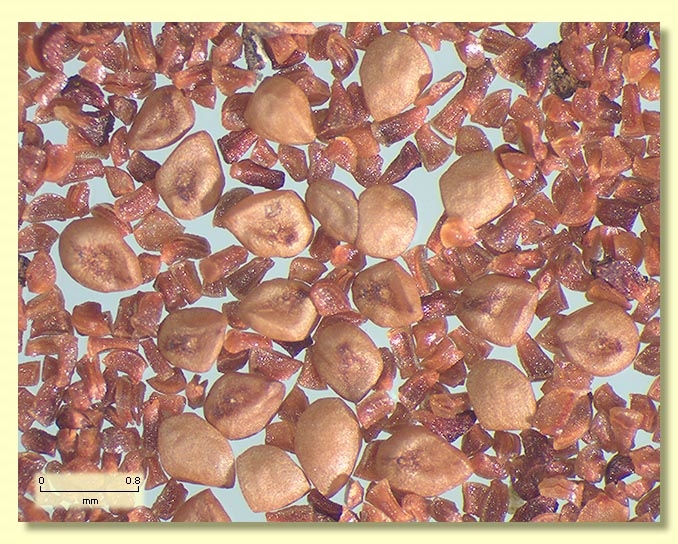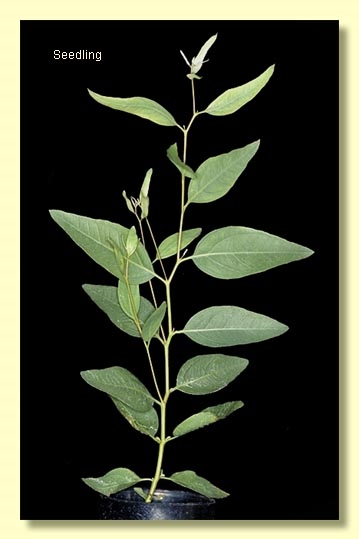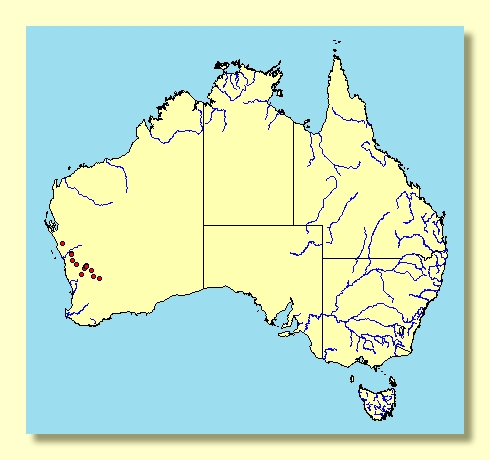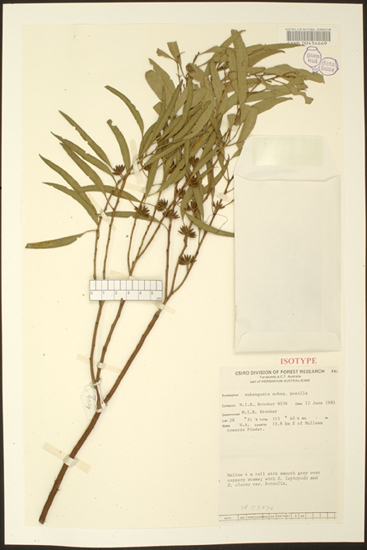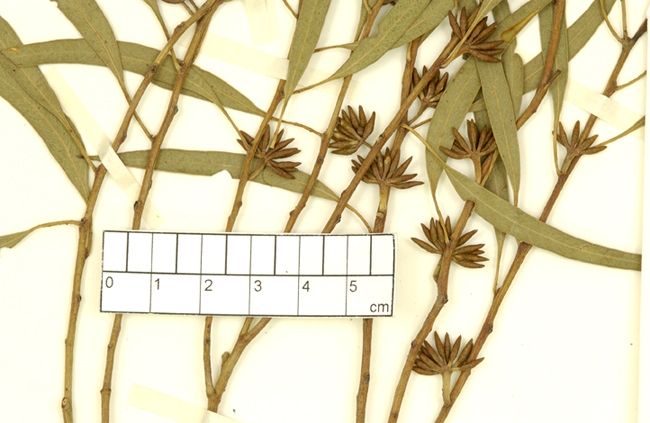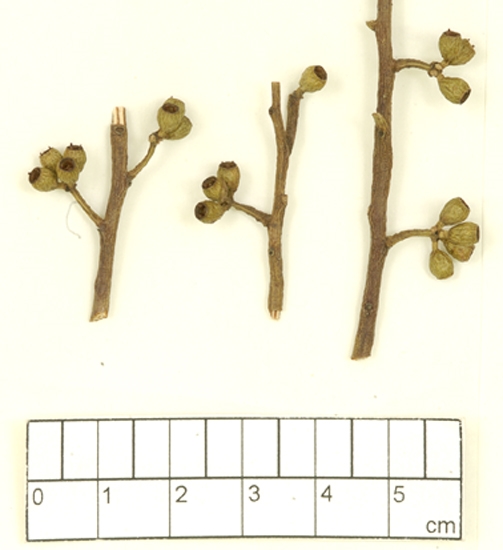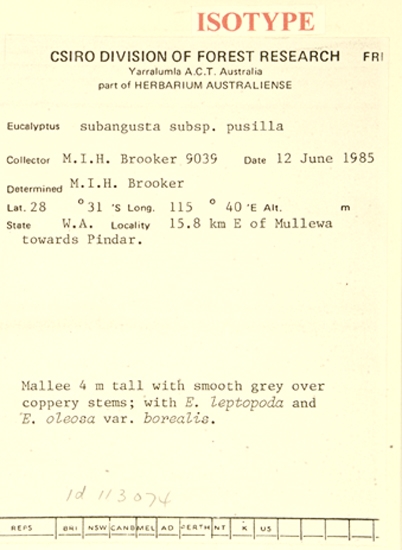Eucalyptus | Symphyomyrtus | Bisectae | Glandulosae | Levispermae | Cubiformes
Euclid - Online edition
Eucalyptus subangusta subsp. pusilla
Classification
Nomenclature
Description
Small tree or mallee to 7 m tall. Forming a lignotuber.
Bark smooth throughout, pale and dark grey and grey brown to pinkish and coppery.
Branchlets have oil glands in the pith.
Juvenile growth (coppice or field seedlings to 50 cm): stems rounded in cross-section, smooth, non-glaucous; leaves always petiolate (petioles 0.4—0.9 cm), alternate, lamina linear to lanceolate, 4.8–9.5 cm long, 0.8—1.4 cm wide, base tapering to petiole, margin entire, apex pointed, dull, green.
Adult leaves alternate, petioles 0.7–1.8 cm long; blade narrowly lanceolate to, 6.5–12 cm long, 0.5–1.5 cm wide, base tapering to petiole, margin entire, apex attenuate, concolorous, dull, light green, side-veins at an acute or wider angle to midrib, reticulation moderate to dense or partly obscured by large island and intersectional oil glands, intramarginal vein remote from margin.
Inflorescence axillary unbranched, peduncles widening apically, 0.5–1.5 cm long, buds 9 to 13, pedicellate (pedicels 0.1–0.2 cm long). Mature buds fusiform (0.5–0.8 cm long, 0.2–0.25 cm wide), scar present, operculum narrowly conical, more or less acute, only slightly longer than hypanthium and equal to it in width at the join, few outer stamens erect, most stamens variably deflexed, anthers oblong, versatile, dorsifixed, dehiscing by longitudinal slits, style long and straight, stigma blunt to rounded, locules 3, the placentae each with 4 vertical rows of ovules. Flowers white.
Fruit pedicellate (pedicels 0.1–0.2 cm long), shortly barrel-shaped, 0.3–0.5 cm long, 0.3–0.4 cm wide, disc descending vertically, valves 3, near rim level or slightly exserted.
Seeds mid-brown to straw-coloured, 0.5–1 mm long, cuboid to sub-spherical, surface smooth, hilum ventral/terminal.
Cultivated seedlings (measured at node 10): cotyledons Y-shaped (bisected); stems rounded in cross-section; leaves always petiolate, opposite for 4 or 5 nodes then alternate, lanceolate, 5–9.5 cm long, 1.5–3 cm wide, sometimes undulate, dull, green to grey-green, slightly glossy by node 10. New growing tips may be waxy but seedlings otherwise non-glaucous.
Bark smooth throughout, pale and dark grey and grey brown to pinkish and coppery.
Branchlets have oil glands in the pith.
Juvenile growth (coppice or field seedlings to 50 cm): stems rounded in cross-section, smooth, non-glaucous; leaves always petiolate (petioles 0.4—0.9 cm), alternate, lamina linear to lanceolate, 4.8–9.5 cm long, 0.8—1.4 cm wide, base tapering to petiole, margin entire, apex pointed, dull, green.
Adult leaves alternate, petioles 0.7–1.8 cm long; blade narrowly lanceolate to, 6.5–12 cm long, 0.5–1.5 cm wide, base tapering to petiole, margin entire, apex attenuate, concolorous, dull, light green, side-veins at an acute or wider angle to midrib, reticulation moderate to dense or partly obscured by large island and intersectional oil glands, intramarginal vein remote from margin.
Inflorescence axillary unbranched, peduncles widening apically, 0.5–1.5 cm long, buds 9 to 13, pedicellate (pedicels 0.1–0.2 cm long). Mature buds fusiform (0.5–0.8 cm long, 0.2–0.25 cm wide), scar present, operculum narrowly conical, more or less acute, only slightly longer than hypanthium and equal to it in width at the join, few outer stamens erect, most stamens variably deflexed, anthers oblong, versatile, dorsifixed, dehiscing by longitudinal slits, style long and straight, stigma blunt to rounded, locules 3, the placentae each with 4 vertical rows of ovules. Flowers white.
Fruit pedicellate (pedicels 0.1–0.2 cm long), shortly barrel-shaped, 0.3–0.5 cm long, 0.3–0.4 cm wide, disc descending vertically, valves 3, near rim level or slightly exserted.
Seeds mid-brown to straw-coloured, 0.5–1 mm long, cuboid to sub-spherical, surface smooth, hilum ventral/terminal.
Cultivated seedlings (measured at node 10): cotyledons Y-shaped (bisected); stems rounded in cross-section; leaves always petiolate, opposite for 4 or 5 nodes then alternate, lanceolate, 5–9.5 cm long, 1.5–3 cm wide, sometimes undulate, dull, green to grey-green, slightly glossy by node 10. New growing tips may be waxy but seedlings otherwise non-glaucous.
Flowering Time
Flowering has been recorded in May, September and October.
Notes
Eucalyptus subangusta is a species of mallee, or a small tree in one subspecies, endemic to Western Australia, widespread in the wheatbelt, extending inland to Paynes Find. The bark is smooth and the adult leaves dull, light green to blue-green, becoming glossy green in one subspecies.
Eucalyptus subangusta belongs to Eucalyptus subgenus Symphyomyrtus section Bisectae subsection Glandulosae because the cotyledons are bisected, buds have an operculum scar and the branchlets have oil glands in the pith. Within this subsection E. subangusta is one of a group of 14 species that form series Levispermae subseries Cubiformes, characterised by having smooth almost cuboid to sub-spherical seed (not spherical), flattened peduncles that widen apically and buds that are narrowly fusiform with some stamens erect and others variably deflexed.
E. subangusta is distinguished from other species in this group by the small fusiform buds with relatively blunt opercula that are about equal to the hypanthium in length (never long and slender), small fruit, narrow leaves and smooth bark. The seed of E. subangusta is the most cuboid of the species in this group. Other species in this cuboid seed group with similarly small buds are E. microshema from the southern Wheatbelt which differs in having an acutely pointy operculum which is narrower than the hypanthium at the join and usually narrower adult leaves; and E. subtilis from south of Norseman which narrower adult leaves and an acutely conical operculum. E. xanthonema from the southern Darling Range, Stirling Range and Fitzgerald River area has pointy, slightly longer buds with operculum longer than the hypanthium. E. subangusta has wider seedling leaves than each of these species.
There are four subspecies:
E. subangusta subsp. subangusta
The most widespread form occurring from Kalbarri in the north, south-east to the scrub east of Hyden, on light sandy soils. Subsp. subangusta is a mallee with dull, non-glaucous, light green to blue-green leaves. The operculum may be bluntly conical to acutely conical.
E. subangusta subsp. cerina
Occurs in the central to east-central wheatbelt, east of Perth, from Yelbeni to east of Southern Cross, on sandy to gravelly sites. Subsp. cerina is a mallee distinguished from other subspecies of E. subangusta by the glaucous seedlings, coppice and branchlets. It may be confused with E. capillosa subsp. polyclada, also a mallee with glaucous branchlets and dull adult leaves, but this species has scabrid juvenile growth and buds with a longer narrower operculum.
E. subangusta subsp. pusilla
Found from near Wongan Hills north to Yuna near Geraldton and inland almost to Paynes Find, on fine-textured to gravelly soils on the fringe of the wheatbelt. Subsp. pusilla is sometimes a small tree, but may be a mallee. It has the smallest buds and fruit of any species and subspecies in series Levispermae. It is non-glaucous.
E. subangusta subsp. virescens
This form is restricted to two localities east of Perth in the wheatbelt, i.e. north-west of Narambeen and between Manmanning and Watheroo. Subsp. virescens is a mallee with a distinctly glossy green crown.
Eucalyptus subangusta belongs to Eucalyptus subgenus Symphyomyrtus section Bisectae subsection Glandulosae because the cotyledons are bisected, buds have an operculum scar and the branchlets have oil glands in the pith. Within this subsection E. subangusta is one of a group of 14 species that form series Levispermae subseries Cubiformes, characterised by having smooth almost cuboid to sub-spherical seed (not spherical), flattened peduncles that widen apically and buds that are narrowly fusiform with some stamens erect and others variably deflexed.
E. subangusta is distinguished from other species in this group by the small fusiform buds with relatively blunt opercula that are about equal to the hypanthium in length (never long and slender), small fruit, narrow leaves and smooth bark. The seed of E. subangusta is the most cuboid of the species in this group. Other species in this cuboid seed group with similarly small buds are E. microshema from the southern Wheatbelt which differs in having an acutely pointy operculum which is narrower than the hypanthium at the join and usually narrower adult leaves; and E. subtilis from south of Norseman which narrower adult leaves and an acutely conical operculum. E. xanthonema from the southern Darling Range, Stirling Range and Fitzgerald River area has pointy, slightly longer buds with operculum longer than the hypanthium. E. subangusta has wider seedling leaves than each of these species.
There are four subspecies:
E. subangusta subsp. subangusta
The most widespread form occurring from Kalbarri in the north, south-east to the scrub east of Hyden, on light sandy soils. Subsp. subangusta is a mallee with dull, non-glaucous, light green to blue-green leaves. The operculum may be bluntly conical to acutely conical.
E. subangusta subsp. cerina
Occurs in the central to east-central wheatbelt, east of Perth, from Yelbeni to east of Southern Cross, on sandy to gravelly sites. Subsp. cerina is a mallee distinguished from other subspecies of E. subangusta by the glaucous seedlings, coppice and branchlets. It may be confused with E. capillosa subsp. polyclada, also a mallee with glaucous branchlets and dull adult leaves, but this species has scabrid juvenile growth and buds with a longer narrower operculum.
E. subangusta subsp. pusilla
Found from near Wongan Hills north to Yuna near Geraldton and inland almost to Paynes Find, on fine-textured to gravelly soils on the fringe of the wheatbelt. Subsp. pusilla is sometimes a small tree, but may be a mallee. It has the smallest buds and fruit of any species and subspecies in series Levispermae. It is non-glaucous.
E. subangusta subsp. virescens
This form is restricted to two localities east of Perth in the wheatbelt, i.e. north-west of Narambeen and between Manmanning and Watheroo. Subsp. virescens is a mallee with a distinctly glossy green crown.
Origin of Name
Eucalyptus subangusta: Latin subangustus, somewhat narrow, probably referring to the leaves.
subsp. pusilla: Latin pusillus, very small, referring to the buds and fruits which are the smallest in the species.
subsp. pusilla: Latin pusillus, very small, referring to the buds and fruits which are the smallest in the species.
Copyright © CANBR 2020, all rights reserved.

Web edition hosted at https://apps.lucidcentral.org/euclid
